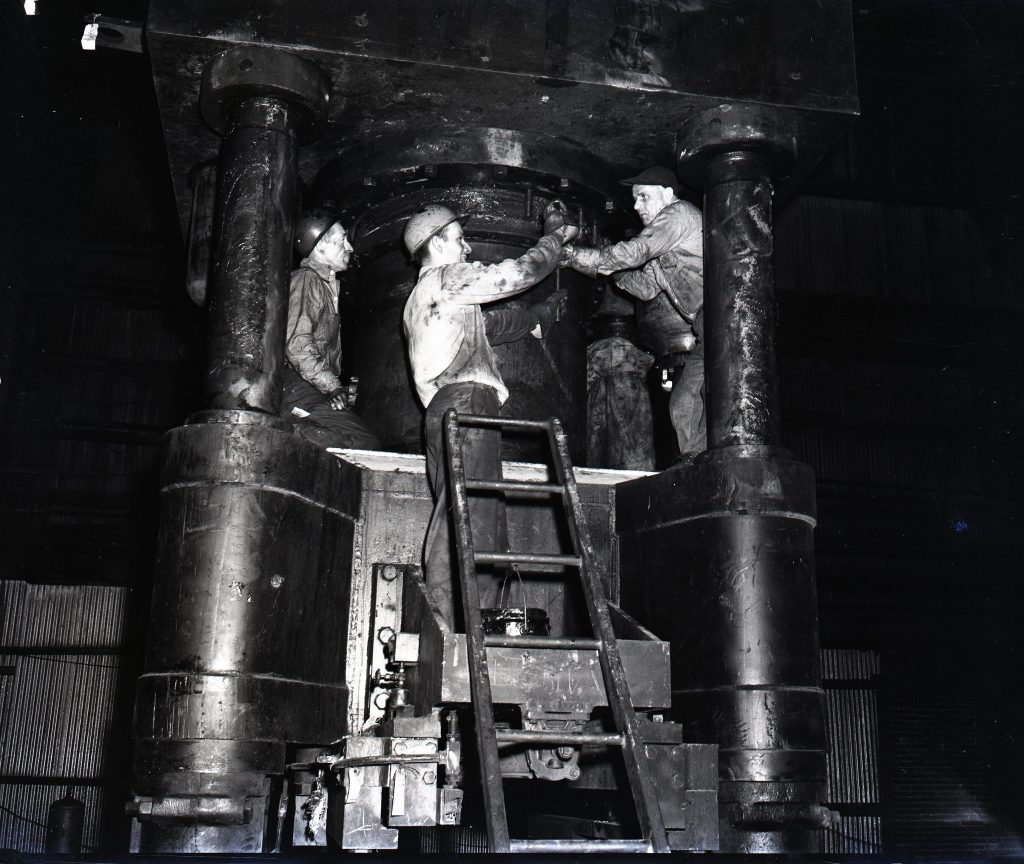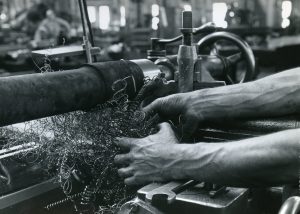The Midvale Steel Collection
This blog was written by volunteer Jim Reiser, who created the inventory for this collection.

The National Canal Museum archive holds over 2,000 glass and acetate negatives, including some contact prints, of operations at the Midvale Steel Company that operated in Nicetown, Pennsylvania outside Philadelphia from 1867 to 1976.1 Midvale was acquired by Bethlehem Steel in 1923 and merged with the Heppenstall Steel Company in 1955. During World War I, it was renamed the Midvale Steel and Ordnance Company, with plants in Johnstown and Coatesville, PA.2
 The collection was donated by Charles Wrege, an American management historian. The items were originally numbered on the negatives themselves, including many of the contact prints, although there are gaps in the collection. Included with the collection are some hand-written keys that indicate roughly the years, from 1930 through 1954, when the pictures were taken. Based on the careful numbering, it appears that there must have been a log to accompany the photos, but unfortunately it has been lost. While the condition of the glass negatives is fair, the acetate negatives have begun to fade. The contact prints are in excellent shape. We know nothing about the photographer or photographers who created this large pictorial record of the plant except for one enigmatic image (Midvale.1) of a photographer huddled under the cloth of a bulky tripod-mounted box camera photographing a piece of equipment assisted by someone holding a light reflective screen. The photographs are all taken with skill and attention to composition, some even bordering on art as in this image of a worker’s bare forearm pulling metal shavings from a lathe (Midvale.2).
The collection was donated by Charles Wrege, an American management historian. The items were originally numbered on the negatives themselves, including many of the contact prints, although there are gaps in the collection. Included with the collection are some hand-written keys that indicate roughly the years, from 1930 through 1954, when the pictures were taken. Based on the careful numbering, it appears that there must have been a log to accompany the photos, but unfortunately it has been lost. While the condition of the glass negatives is fair, the acetate negatives have begun to fade. The contact prints are in excellent shape. We know nothing about the photographer or photographers who created this large pictorial record of the plant except for one enigmatic image (Midvale.1) of a photographer huddled under the cloth of a bulky tripod-mounted box camera photographing a piece of equipment assisted by someone holding a light reflective screen. The photographs are all taken with skill and attention to composition, some even bordering on art as in this image of a worker’s bare forearm pulling metal shavings from a lathe (Midvale.2). 
Most of the collection reflects the company’s focus on ordnance production during World War II and the Korean War. The images record the production of large artillery barrels, shells, and armor plating. Included are series of images showing attempts to load these weapons for transport. One interesting series documents attempts to load a large barrel onto the freighter Niel Maersk during the Second World War. A first attempt was made using the freighter’s own crane which nearly pulls the ship over to final loading using a large shore loading crane (Midvale.3). Years later, during the Korean War, there is a similar series documenting a more modern attempt to load a barrel onto a Slick Airways aircraft, apparently with similar difficulties.
 In the course of documenting the manufacturing processes, the collection provides a glimpse into the changing working conditions in the plant, from workers unprotected in street clothing to the introduction of hard hats, protective eyewear, and dedicated work clothes. Likewise, the collection documents changing office technology from handwritten ledgers to the introduction of early card-punch data machines. During the war years images appear of patriotic rallies, bond drives, safety and blood drives. Included also are scenes of worker unrest as in one image from 1948 of a “Midvale Scab List” hand-painted on the side of a plant building. The collection also documents the changing demographics of the workforce. During World War II images of Black and female workers in the plant are common, but after the war years images of women working in the plant disappear while they come to dominate office spaces. The collection also contains images of the social lives of the workers including images of Midvale baseball and basketball teams and large family picnic and amusement park gatherings.
In the course of documenting the manufacturing processes, the collection provides a glimpse into the changing working conditions in the plant, from workers unprotected in street clothing to the introduction of hard hats, protective eyewear, and dedicated work clothes. Likewise, the collection documents changing office technology from handwritten ledgers to the introduction of early card-punch data machines. During the war years images appear of patriotic rallies, bond drives, safety and blood drives. Included also are scenes of worker unrest as in one image from 1948 of a “Midvale Scab List” hand-painted on the side of a plant building. The collection also documents the changing demographics of the workforce. During World War II images of Black and female workers in the plant are common, but after the war years images of women working in the plant disappear while they come to dominate office spaces. The collection also contains images of the social lives of the workers including images of Midvale baseball and basketball teams and large family picnic and amusement park gatherings.
The collection is now inventoried and available for on-site research. Learn more about how to make an appointment to see this or other collections here: https://canals.org/learn/schedule-a-research-appointment/.























Join the Conversation!